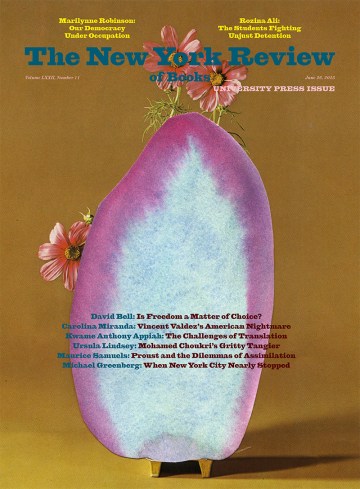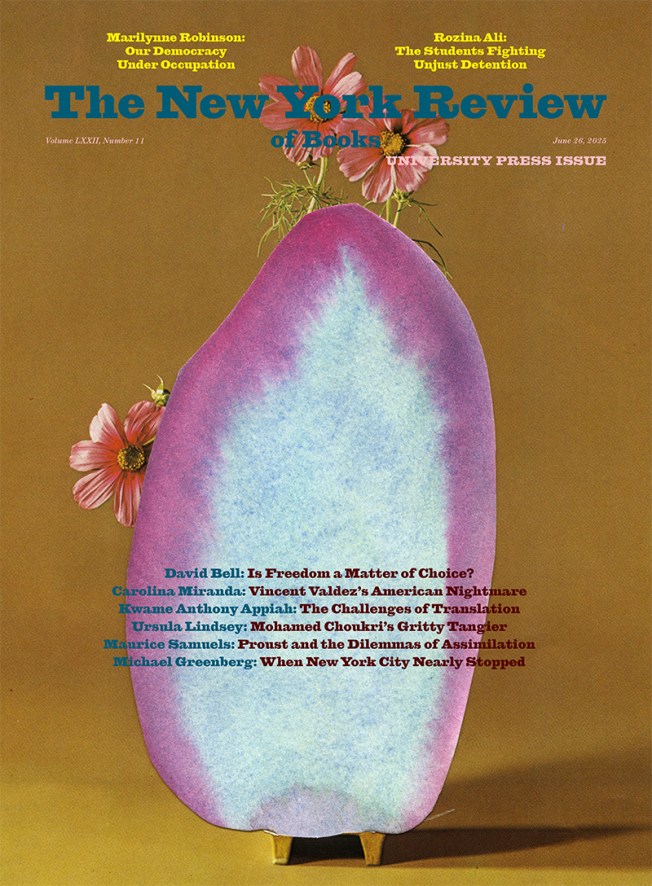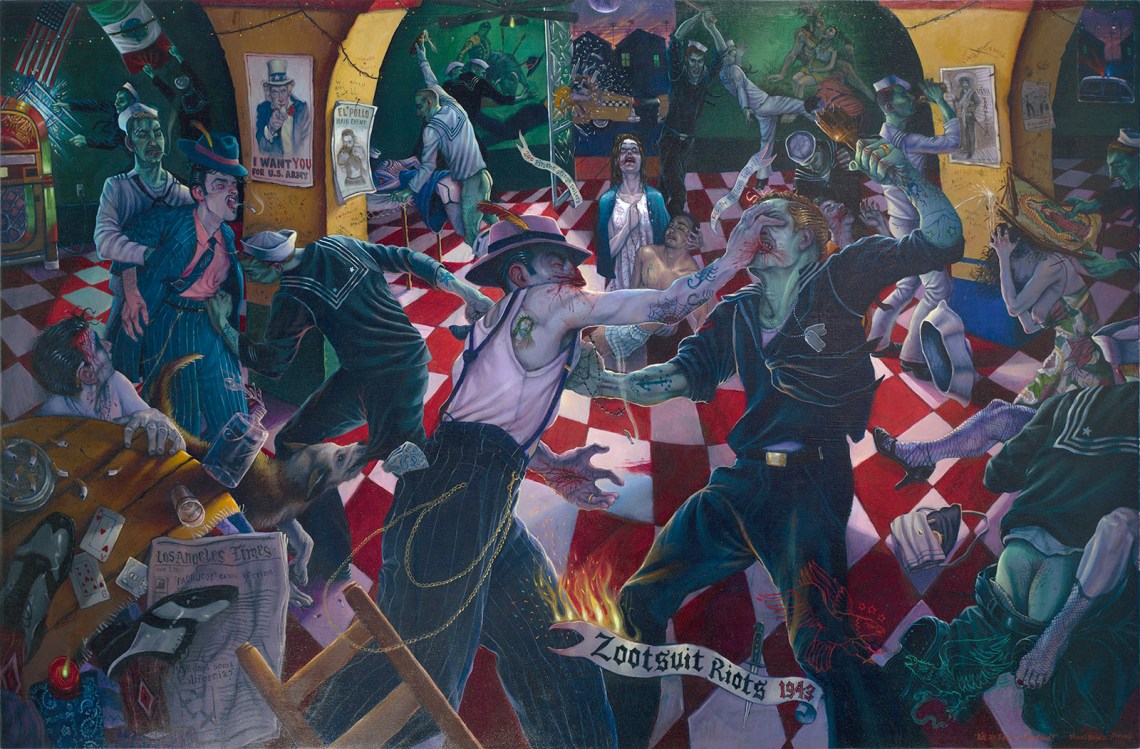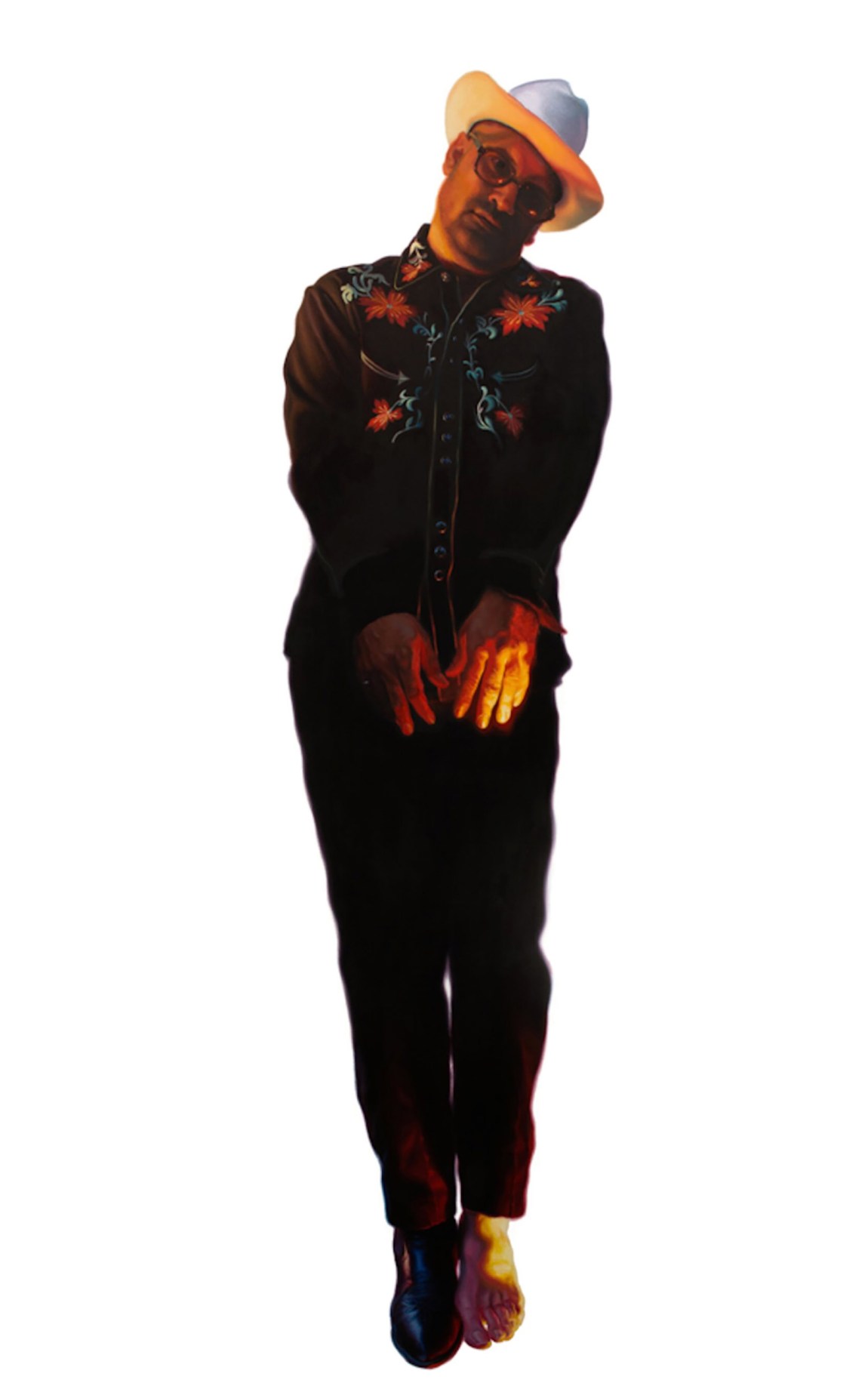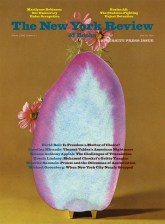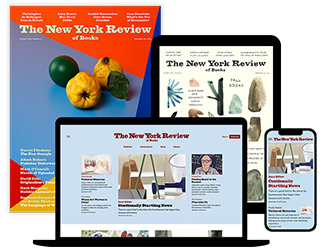Stand before Vincent Valdez’s paintings The City I (2015–2016) and The City II (2016) and you will find that you’ve been transported to a bluff overlooking the twinkling grid of an American city at night. But this is no tranquil vista. At left a fire smolders in an oil drum before a mound of discarded mattresses. At right the headlights of a Chevy pickup illuminate a gathering of more than a dozen people in Klan hoods. One holds a torch, another a rifle, and yet another nurses a tallboy as he throws up his arm in a Nazi salute. A baby—also dressed in Klan regalia—points its pudgy finger at you accusingly. Most of the group peers directly at you, as if they’ve just noticed your presence, or perhaps had been aware of your presence but have now decided your fate.
Rendered in moody black and white, these meticulous realist paintings are larger than life: each reaches a height of more than six feet, with The City I extending over four panels to a width of thirty feet. At the Contemporary Arts Museum Houston (CAMH), where I saw them in February, they were presented in a U-shaped space that enveloped the viewer. To gaze on them was to be surrounded by the Klan—not the Ku Klux Klan of some historical night-riding past but the Klan that doggedly persists into the present. One of the hooded figures can be seen casually examining his cell phone, which bathes the insignias on his robe in a sickly glow.
Valdez is not the first artist to make the KKK his subject. Aaron Douglas painted a frightening vision of Klan members on horseback in his mural Aspects of Negro Life: From Slavery to Reconstruction (1934), now housed at the Schomburg Center for Research in Black Culture in Harlem. Decades later the Alabama-born photographer William Christenberry created a series of disquieting images of dolls in Klan garb, partly inspired by a rally he once witnessed in Tuscaloosa. (“I have never seen anything more frightening than those eyes glaring through those eyehole slits,” he later said.) And of course there was Philip Guston, who grew up in the Los Angeles area at a time when Klan members openly occupied high-level positions in various local municipalities. The artist’s early works from the 1930s (including a large-scale mural he painted in Morelia, Mexico, with Reuben Kadish and Jules Langsner) were indictments of Klan racism and violence. But Guston’s late paintings, produced in the 1960s and 1970s, are the ones that brought him lasting renown, depicting cartoonish figures in Klan hoods who serve as malleable symbols of villainy.*
Valdez’s work is partly inspired by Guston—specifically his City Limits (1969), which shows a trio of hooded figures driving along a city street, their white sheets stained with the blood of some heinous act. But Valdez also draws from his own experience: when he was sixteen he stumbled into a white nationalist rally in San Antonio that included a crew of hooded Klan members. Years later he recalled one of them looking at him, then declaring, “You don’t belong here.” That anxious sensation, of being sized up by a group of white supremacists, is the electric charge that runs through The City I and II. As I stood in the gallery, a shiver raced up my spine.
The City I and II are part of the Texas artist’s first major museum survey, “Vincent Valdez: Just a Dream…,” which was on view at CAMH through March and is now open, in slightly expanded form, at the Massachusetts Museum of Contemporary Art (MASS MoCA) in the Berkshires. The exhibition gathers dozens of works made throughout Valdez’s prolific career—paintings, drawings, and even a vintage Good Humor ice cream truck painted with scenes of LA—that ruminate on the violence and disenfranchisement haunting US history.
His investigations are as thought-provoking as they are formally magnificent. Take his 2013 series The Strangest Fruit, in which Valdez reflects on the relatively little-known history of Mexican lynchings. Throughout the late nineteenth and early twentieth centuries, Mexicans, like African Americans, were often the targets of Anglo lynch mobs. The artist’s native Texas was the site of a notorious mass lynching in 1918, when fifteen Mexican men and boys were killed at Porvenir by a group of vigilantes that included members of the US Army and the Texas Rangers.
The Strangest Fruit is a series of life-size paintings that shows Mexican men in contemporary dress against white backgrounds. At first glance the men appear to float, as if in the process of heavenly ascension. But look again and you’ll see their bodies splayed at awkward angles and their heads thrown back in unnatural ways. Valdez doesn’t depict the implements of death—there are no ropes or bloody bullet wounds. But the men’s contorted poses get the brutality across.
Advertisement
CAMH presented eight of the ten paintings that make up this series, and collectively they tell a story of ordinary lives cut short by hate. One man looks like a run-of-the-mill rocker, another wears the jersey of his favorite basketball team. Valdez diligently paints the adornments that define each man’s style, be they the fine line of a tattoo or the weave of an Indigenous bracelet. But most remarkable is the way he wields light. Each of the men is bathed in otherworldly rays—light that might emanate from the sun at dusk or perhaps the headlights of a Chevy pickup at night.
Valdez was born in San Antonio in 1977 to a Mexican American family that had lived in Texas for generations. Almost as soon as he could hold a pencil he was drawing, and by the age of nine he was helping the prominent San Antonio artist Alex Rubio produce public murals around the city as part of a community arts program. Valdez was an artistic prodigy with a keen awareness of politics. When he was in fifth grade, as noted in the exhibition’s thoughtful catalog, he was among a group of students who produced a mural that a local television station reported on. In that segment a fellow student described painting flowers and butterflies; Valdez had painted a scene that featured farmworkers harvesting crops as a fighter jet flew overhead, accompanied by a slogan reading “MAKE FOOD NOT WAR.” When asked about his work, the young artist responded, “In the future will there be any animals left, any flowers or air left to breathe? Will I still be around?”
“Just a Dream…” captures the evolution of an artist who eludes tidy categorization. Valdez got his early training as a muralist, but his art generally avoids the iconography typical of Chicano muralism, such as Mexican revolutionary heroes or Aztec motifs. This may be because Rubio, his mentor, is himself a bit of a maverick, using color, pattern, and distortion in ways that draw more from 1960s psychedelia than from anything produced by Diego Rivera. But it’s also likely rooted in Valdez’s growing up not in the heyday of the Chicano civil rights movement of the 1970s, when Chicano muralism flourished, but later, during the era of Ronald Reagan and MTV. Recurring symbols in his early drawings include basketball stars as well as the signifiers of urban life in the Southwest: low-slung bungalows, barking dogs, industrial infrastructure, and brand-name kicks. Valdez’s artistic trajectory also runs counter to the tendencies of other US artists of his generation who came of age in the digital era. When he completed his undergraduate studies at the Rhode Island School of Design (RISD) in 2000, many artists were turning their attention to video, performance, conceptual photography, and installation; globalism was a running theme. Valdez instead turned to explorations of history and the human figure.
The survey takes us to the very beginning. Viewers at CAMH were invited to pore over a flat file from Valdez’s studio containing ephemera that dates back to his childhood. (The file also made the journey to Massachusetts.) Among photographs and news clippings, you’ll come across classroom sketches, preparatory studies for his mural work, and a tender drawing of a plate of beans and carnitas cooked by his grandmother. The file reveals a dexterous artist who was using fine lines and scathing wit in ways that evoke Dürer and Daumier by the time he was a teenager. In one sketch, made when he was around fourteen, Valdez personifies the year 1991 as Baby New Year—except this baby is wearing a gas mask and dragging the American flag across the floor as it crawls; 1991 was the year the US first invaded Iraq. (The catalog, incidentally, provides a similar sensation of rummaging through his belongings: bound into its pages is a zine-like insert that features photographs of his studio spaces. The artist now divides his time between Houston and Los Angeles.)
By his twenties Valdez was using the human figure to explore the vagaries of American history in ways both alluring and unsettling. The exhibition features some of these early works, such as Kill the Pachuco Bastard! (2001), begun when he was a student at RISD. The painting takes as its subject the Zoot Suit Riots of 1943, when gangs of US servicemen prowled the streets of Los Angeles, attacking any Mexican who wore a zoot suit. The police looked the other way, but when they did make arrests it was generally of the Mexican victims. In one large horizontal canvas, Valdez imagines a scene from that era, taking us inside a bar that has devolved into mayhem. In the foreground a sailor and a pachuco are locked in bloody hand-to-hand combat. Behind them a woman holds a Mexican man who is unconscious and has been stripped of his suit. To the right a serviceman rapes a woman, his pimply, hairy ass prominently displayed. The colors are as lurid as the violence: Valdez renders skin tones in queasy shades of purple and green.
Advertisement
Kill the Pachuco Bastard! shows the young painter synthesizing an array of visual languages and making them his own. The startling hues hark back to Rubio’s work, while the choreographic poses of the figures channel the late Luis Jiménez (also a native of Texas), who was known for rendering the human body in highly stylized ways. But one of the painting’s most remarkable qualities is its distortion of the room, as if we were viewing it through a fish-eye lens—bringing to mind the tilting, disorienting spaces imagined by German Expressionist filmmakers. To stand before Kill the Pachuco Bastard! is to feel as if the room (and society) were spinning.
Valdez made other paintings using this approach, such as the smaller, more serene Recuerdo (1999), which shows his grandfather, cigarette dangling jauntily from his lips, playing the accordion on a patio illuminated by red votive candles. But it is a series of large-scale charcoal drawings that Valdez produced in the early 2000s that marks the foundation of his mature style. Stations, inspired by the Catholic Stations of the Cross, imagines a boxer—that symbol of bare-knuckle working-class aspiration—as a stand-in for Christ in his final hours. In this series an unnamed pugilist is presented to a hollering crowd and endures unspeakable violence in the ring, and in the end, his body—it’s unclear whether dead or unconscious—is laid out on a table in a dingy locker room, the final image bringing to mind the bleakness of Hans Holbein’s The Body of the Dead Christ in the Tomb.
Unlike in Valdez’s previous work, which is more stylized, these figures are rendered realistically and in black and white. But what gives the series its dynamism is the way he continually shifts the viewer’s perspective on his fighter. George Bellows, known for his theatrical paintings of boxing matches in the early twentieth century, often presented fighters from the point of view of a spectator sitting in the stands. Valdez instead brings us disconcertingly close to the punches and the bodily fluids. In one drawing you stand directly behind the boxer in the middle of a bout; in another you kneel at his feet as the cornermen attend to his wounds. A vertical drawing titled He Then Fell Once More (2002), which is not in the exhibition, shows an aerial view of the fallen fighter on his back in the ring, as if the viewer were his soul hovering over his body.
The immediacy is thrilling, but just as noteworthy is the nature of the light. In these inky chiaroscuros the source of illumination is often artificial, be it an overhead neon or a camera’s flash. It is garish, severe; at times it seems to emerge from within the drawing, as if the paper were backlit—anticipating the aesthetics of the smartphone screens that mediate our existence. In an interview with Tyler Green on The Modern Art Notes podcast, Valdez described this look as “high-definition” realism, alluding to the textureless gloss and harsh tones of high-resolution digital television. As a child Valdez used to trace images directly from the TV screen, pausing the VCR so he could capture a scene.
CAMH displayed only four of the thirteen works that make up Stations—which felt like an oversight. This series was formative for Valdez; the astonishing detail would become a signature component of his later work. It is also a thoughtful meditation on social class, struggle, and brutality. (MASS MoCA has a more complete display, with ten drawings from the series on view.) Over the years boxers have been a recurring subject for Valdez, and the survey did include other central works featuring them. A series of drawings from 2012 shows boxers striking prefight poses for the camera, while the painting Just a Dream (In America) (2020–2021) depicts a bruised slugger looking exhausted. “Growing up in a Chicano community,” Valdez told Green, “the idea about boxing as being one’s sort of ticket—the golden ticket—out of the barrios, the ghettos in America, is a very real legacy.” It’s an idea that lends itself to his quasi-religious treatment of the sport: to escape poverty and violence, young men subject themselves to further flagellation in the ring.
Other work in the show feels conceptually flimsier. The New Americans series, which he began in 2021, consists of portraits of people—artists and activists—who are fighting for change. The images are striking, but Valdez is most magnetic when portraying underdogs and antiheroes. Greeting visitors to the show at CAMH was his 2019 canvas So Long, Mary Ann, which features an anonymous man with a shaved head whose face and torso are covered in tattoos that could be read as signifiers of gang affiliation. Prominently inked across his chest are the words “West Side.” He bears more than a passing resemblance to the incarcerated men trotted out before the cameras at CECOT, the notorious Salvadoran megaprison to which the US has deported dozens of migrants. But instead of holding this figure up as a dehumanized object of savagery, Valdez approaches him with ambivalence, obscuring his face in tattoos while bathing him in angelic pink and blue light. The man’s hands are clasped gently before him; his gaze feels plaintive. Move in close and you can make out the scars on his body. Within the archetype of the fearsome gangbanger resides a person, who perhaps has been as much a victim of violence as its perpetrator.
Valdez is a skilled painter poking at the dark recesses of the national psyche, grappling with the ways power is wielded, often by the state against its own citizens—which strikes a particularly resonant note amid the ongoing depredations of the Trump regime. Parked in one gallery at CAMH was a Good Humor truck covered in a sequence of paintings recounting the story of the LA neighborhood that was razed to make way for Dodger Stadium, with scenes of forced evictions set against a backdrop of eerie red—a work Valdez created at the invitation of the musician Ry Cooder to mark the release of his 2005 album Chávez Ravine. Nearby a sculptural installation, created with the artist Adriana Corral (who is also Valdez’s partner), paid tribute to José Campos Torres, a serviceman who was murdered by Houston police in 1977 and whose untimely death helped fuel the Chicano movement. It’s elegant and stirring: in niches carved into a large-scale white monolith the artists embedded a portrait of Torres, as well as a statue of the Virgin Mary made out of silt taken from the bayou where Torres’s body was found.
And of course there are the uncompromising Klan paintings, which capture the group’s menacing rituals and the insidious endurance of its ideas. The Klan is best known for its violent enforcement of white supremacy, but during its early-twentieth-century heyday the group had an extensive political platform that also included opposing immigration, labor unions, Catholicism, international cooperation, sexual liberation, gender equality, and cultural and religious pluralism. Klan members often functioned as their town’s de facto morality police, when they weren’t occupying official positions of power. Today the Klan as an organization is atomized and marginalized, yet its ideals saturate Trump’s far-right agenda.
Valdez’s exhibition is titled “Just a Dream…” It’s an apt name, since the American dream, like any other, is illusory, fantastical, fleeting. Reality, as Valdez shows, is darker, more violent, and infinitely more difficult to engage with.
-
*
See Susan Tallman, “Philip Guston’s Discomfort Zone,” The New York Review, January 14, 2021. ↩
